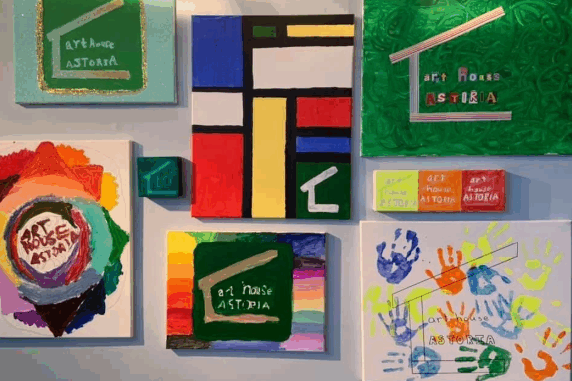
BY JAIDA DENT
Where New York City public schools are lagging on providing a proper arts curriculum, one organization in Queens helps fill the gap that students are missing throughout the day.
Art House Astoria Conservatory for Art and Music is a non-profit organization founded in 2009 by Executive Director Micah Burgess and his wife, Jane Burgess, the Director of Marketing. The organization provides a range of programming, including theater, fine arts, and music lessons. The mission of Art House Astoria emphasizes inclusion for all within the arts, and makes this possible through hosting classes at its own facility and partnering with other Queens schools.
“Our goal is to provide affordable arts education for the community. We believe that arts education should be accessible for anyone, regardless of income, ability, or age,” said Burgess.“We’re not a great substitute for having a full-time music teacher, art teacher, theater teacher. We’re doing the absolute best we can with budgets that PTAs can afford or with grant money that comes in. It’s very limited,” said Burgess. “I don’t want to downplay what we’re doing because I think it’s really important, but I think the best thing for the kids would be if they had a full-time faculty.”
While New York City bleeds arts and entertainment, many public schools are failing to meet All NYC Public Schools are expected to meet the required number of hours/units of arts for each student, which differs by grade as well. Students in grades four to six are required to have 10 percent of their weekly time, about 93 hours throughout the school year, allocated for the arts, where students in grades seven to eight should complete 110 hours of arts instruction through two of four different media (visual art, dance, music, or theater).
Many schools provide at least one form of arts education, but each school’s curriculum varies based on how many certified teachers they have. “From 2020-2023, public schools lost 425 full-time certified arts teachers, and only 31% of eighth-grade students meet state requirements for arts education,” according to an article by the BK Reader.
In April of this year, the City Council’s Committee on Education and Committee on Cultural Affairs, Libraries, and International Intergroup Relations held a hearing to discuss these inequities in arts education at public schools. Brooklyn Councilmember Rita Joseph opened the hearing, sharing her sentiments towards arts education.
“Arts education is a key component of a well-rounded education that fosters creativity, critical thinking, and problem-solving skills,” said Joseph. “For students from historically marginalized communities, exposure to arts education provides an essential avenue for self-instruction, cultural affirmation, and access to potential career pathways in creative industries.”
While it can’t substitute for what schools fail to provide, Art House Astoria has a mission rooted in arts for all and finds a way for students to participate regardless of financial or physical restraints. The organization operates as a tuition-based program, but it does provide financial assistance for its students based on income, recognizing the federal poverty line. In 2023, the Queens poverty rate was 13.7 percent compared to the citywide 18.2 percent, according to data from the NYU Furman Center.
“Somebody could be making a lot more over the federal poverty line and still need assistance here, because the cost of living is so much higher,” Burgess said. “So people can fill out the application, like I said, family size, and then we just apply that formula as long as we have funding available, then they’ll get whatever is sort of recommended.”
When it comes to students with special needs or disabilities, Art House Astoria doesn’t see a need for separation, but rather integration. All students participate in the same classes with accommodations as needed. This topic rings home for Burgess, as his son has special needs and is still able to participate in the programming offered.
“He’s not taking the special needs theater class. He’s taking [the] theater class,” Burgess said. “Does he wander off sometimes and do his own thing? Yes, but we want to make sure that kids, him, and kids like him are accommodated in our programs in a way that they feel included.”
Administrative Coordinator Brooke Vahos echoed the same message. “It’s so important that everybody has the opportunity to make art, right?” said Vahos. “It should be, like, just something that we’re all able to do and empowered to do. I think that’s important that it’s part of our mission, because we make it a welcoming space for kids, and we kind of, like, redefine, I think, in a lot of ways, what our programming can be and who can participate in that, if that makes sense.”
Art House Astoria aims to create spaces geared towards every type of person and student. “Having it integrated, I think, is a testament to how normal it is,” Vahos said. “That these people are amongst us, are us, like, are in our families, are in our schools. It’s spectacular, and it’s a hard thing to do, which is to navigate this world with a disability or to have a child that’s navigating this world with a disability, but they have the same, like, hopes and dreams and hobbies as all of us.”
Though public schools have a long way to go in providing well-rounded arts education for students, Art House Astoria offers a space for students’ self-expression and creativity.
“We want to make sure that anyone who comes in here feels like it’s a safe space,” said Burgess. “We want those kids who don’t feel like they have a place in their school or whatever community that they live in most of the time, if they feel like they’re sort of at odds with that, and they feel like sort of the odd duck, we want them to know that this is a place that they can come and feel comfortable.”
